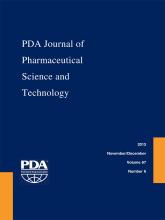Abstract
In Part 1 of this three-part research series, a leak test performed using high-voltage leak detection (HVLD) technology, also referred to as an electrical conductivity and capacitance leak test, was developed and validated for container–closure integrity verification of a small-volume laminate plastic bag containing an aqueous solution for injection. The sterile parenteral product is the rapid-acting insulin analogue, insulin aspart (NovoRapid®/NovoLog®, by Novo Nordisk A/S, Bagsværd, Denmark). The aseptically filled and sealed package is designed to preserve product sterility through expiry. Method development and validation work incorporated positive control packages with a single hole laser-drilled through the laminate film of each bag. A unique HVLD method characterized by specific high-voltage and potentiometer set points was established for testing bags positioned in each of three possible orientations as they are conveyed through the instrument's test zone in each of two possible directions—resulting in a total of six different test method options. Validation study results successfully demonstrated the ability of all six methods to accurately and reliably detect those packages with laser-drilled holes from 2.5–11.2 μm in nominal diameter. Part 2 of this series will further explore HVLD test results as a function of package seal and product storage variables. The final Part 3 will report the impact of HVLD exposure on product physico-chemical stability.
LAY ABSTRACT: In this Part 1 of a three-part research series, a leak test method based on electrical conductivity and capacitance, called high voltage leak detection (HVLD), was used to find leaks in small plastic bags filled with an insulin pharmaceutical solution for human injection by Novo Nordisk A/S (Bagsværd, Denmark). To perform the test, the package is electrically grounded while being conveyed past an electrode linked to a high-voltage, low-amperage transformer. The instrument measures the current that passes from the transformer to the electrode, through the packaged product and along the package walls, to the ground. Plastic packages without defect are relatively nonconductive and yield a low voltage reading; a leaking package with electrically conductive solution located in or near the leak triggers a spike in voltage reading. Test methods were optimized and validated, enabling the detection of leaking packages with holes as small as 2.5 μm in diameter. Part 2 of this series will further explore HVLD test results as a function of package seal and product storage variables. The final Part 3 will report the impact of HVLD exposure on product stability.
- Container-closure
- Container-closure integrity
- Defects
- Electrical conductivity and capacitance leak detection
- Form-fill-seal packages
- High-voltage leak detection
- HVLD
- Leak
- Leakage
- Leak detection
- Leak test method
- Package
- Package defects
- Package integrity
- Package integrity method
- Plastic laminate bag
- Protein product
- Stability
- Insulin.
- © PDA, Inc. 2013
PDA members receive access to all articles published in the current year and previous volume year. Institutional subscribers received access to all content. Log in below to receive access to this article if you are either of these.
If you are neither or you are a PDA member trying to access an article outside of your membership license, then you must purchase access to this article (below). If you do not have a username or password for JPST, you will be required to create an account prior to purchasing.
Full issue PDFs are for PDA members only.
Note to pda.org users
The PDA and PDA bookstore websites (www.pda.org and www.pda.org/bookstore) are separate websites from the PDA JPST website. When you first join PDA, your initial UserID and Password are sent to HighWirePress to create your PDA JPST account. Subsequent UserrID and Password changes required at the PDA websites will not pass on to PDA JPST and vice versa. If you forget your PDA JPST UserID and/or Password, you can request help to retrieve UserID and reset Password below.






